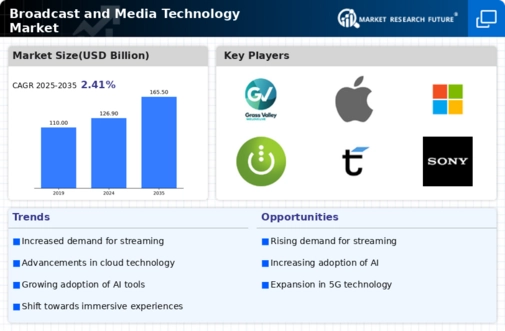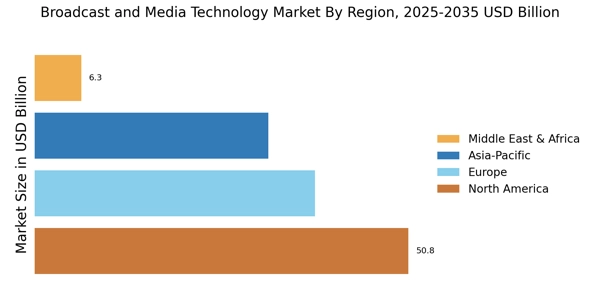Expansion of Mobile Broadcasting
The proliferation of mobile devices has catalyzed a transformation within the Broadcast and Media Technology Market, as mobile broadcasting becomes increasingly prevalent. With the rise of smartphones and tablets, consumers now expect to access content anytime and anywhere. This trend has prompted broadcasters to optimize their content for mobile platforms, leading to the development of mobile applications and adaptive streaming technologies. Recent data indicates that mobile video consumption is expected to account for over 75% of total online video traffic by 2025. Consequently, the Broadcast and Media Technology Market is adapting to meet these demands, focusing on mobile-friendly solutions that enhance accessibility and user engagement.
Integration of Artificial Intelligence
Artificial Intelligence (AI) is emerging as a transformative force within the Broadcast and Media Technology Market, offering innovative solutions for content creation, distribution, and audience engagement. AI technologies, such as machine learning and natural language processing, enable broadcasters to analyze viewer preferences and tailor content accordingly. This personalization enhances viewer retention and satisfaction. Furthermore, AI-driven automation in production processes is streamlining workflows, reducing costs, and improving efficiency. Industry analysts suggest that the implementation of AI in broadcasting could lead to a reduction in operational costs by up to 30%. As such, the Broadcast and Media Technology Market is increasingly investing in AI capabilities to remain competitive and responsive to evolving consumer needs.
Increasing Demand for High-Quality Content
The Broadcast and Media Technology Market is witnessing a pronounced demand for high-quality content, driven by consumer preferences for superior viewing experiences. As audiences become more discerning, content creators and distributors are compelled to invest in advanced production technologies. This trend is reflected in the growing adoption of 4K and 8K resolution formats, which enhance visual clarity and detail. According to industry reports, the market for high-definition content is projected to expand significantly, with a compound annual growth rate of over 15% in the coming years. This shift not only elevates viewer satisfaction but also encourages broadcasters to innovate, thereby fostering a competitive landscape within the Broadcast and Media Technology Market.
Rise of Interactive and Immersive Experiences
The Broadcast and Media Technology Market is experiencing a notable shift towards interactive and immersive experiences, driven by advancements in virtual reality (VR) and augmented reality (AR) technologies. These innovations are reshaping how audiences engage with content, allowing for more participatory viewing experiences. As broadcasters explore these technologies, they are creating opportunities for enhanced storytelling and audience interaction. Recent studies indicate that immersive content can increase viewer engagement by up to 50% compared to traditional formats. This trend is prompting investments in AR and VR capabilities within the Broadcast and Media Technology Market, as companies seek to differentiate themselves and capture the attention of tech-savvy audiences.
Regulatory Changes and Compliance Requirements
The Broadcast and Media Technology Market is navigating a complex landscape of regulatory changes and compliance requirements that impact content distribution and broadcasting practices. Governments are increasingly implementing regulations aimed at ensuring fair competition, protecting intellectual property, and safeguarding consumer rights. These regulations can influence how content is produced, distributed, and monetized. For instance, recent legislative measures have introduced stricter guidelines on data privacy and content accessibility. As a result, broadcasters must adapt their strategies to comply with these evolving regulations, which may involve investing in new technologies and processes. This dynamic regulatory environment presents both challenges and opportunities for the Broadcast and Media Technology Market, as companies strive to balance compliance with innovation.


















Leave a Comment